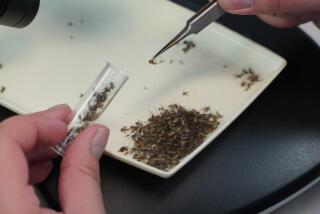Giant mosquitoes in Florida? Yes, but don’t cancel your vacation
- Share via
Florida, land of the giant invasive snail, and the giant invasive python, is also home to a giant, indigenous mosquito, which may come out in force this summer, if the rains are just right.
The extra-large Psorophora ciliata, known colloquially as a shaggy-legged gallinipper, or simply a gallinipper, is three to five times the size of an average mosquito, as you can see in the photo above.
It also happens to be an especially handsome mosquito, if you are into that kind of thing. It is slightly irridescent with dark wings and banded legs. The last segments of its legs are white -- almost as if they were dipped in paint. And if you click to the second photo above, you’ll see that its legs look a bit furry, which is where the “shaggy-legged’ part of its name comes from. You can especially see the shagginess in the leg that is lifted high in the air.
PHOTOS: Meet the top 10 newly identified species of 2012
The gallinipper has an unusual life cycle. Females lay their eggs in low-lying dry areas that were once filled with water -- places like divots in a cow pasture that might fill with water for four or five days after a heavy rain and then dry out again. The eggs don’t hatch until the area re-floods, and the eggs can wait for years in an unhatched state if necessary until conditions are favorable.
Then, when a big rain comes and the area floods, a huge number of mosquitoes hatch all at once.
Last year was an especially bad year for gallinippers in Florida, because Tropical Storm Debby dumped 15 inches on the state in June, flooding lots of low-lying lands. Still, the gallinipper problem was mostly contained to rural areas, where divots in pastures might occur, said Phil Kaufman, an entomologist at the University of Florida in Gainesville.
“You won’t find these mosquitoes in Orlando or Miami,” he said.
This year, a few gallnippers have been spotted in insect traps in the northern part of the state, but not many. One scientist found two gallinippers in a series of traps that collected 30,000 mosquitoes over all. Kaufman said it will be a few more weeks before scientists know if Tropical Storm Andrea will be responsible for another outbreak.
While nobody wants gallinippers zipping around the state “blood feeding” as it is called, they are not necessarily as bad as their large size would imply. Kaufman said most people find gallinipper bites are no more itchy than other mosquito bites, and on the plus side, gallinipper larvae feast on other mosquitoes, keeping their competitors’ numbers down.
Finally, it should be noted that the gallinipper’s natural habitat is hardly confined to Florida. The giant mosquito is found throughout the eastern two-thirds of the United States, said Kaufman.







